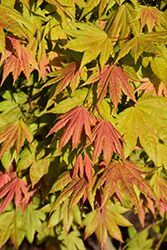Height: 30 feet
Spread: 30 feet
Sunlight:
![]()
![]()
Hardiness Zone: 5a
Description:
This exciting variety produces vivid red spring foliage that matures to chartreuse, followed by vibrant fall color, the effect is stunning; vigorous with increased sun tolerance; an ideal accent for the bright home landscape
Ornamental Features
Moonrise Full Moon Maple has attractive tomato-orange-tipped chartreuse foliage which emerges scarlet in spring on a tree with a round habit of growth. The lobed leaves are highly ornamental and turn outstanding shades of orange and in the fall.
Landscape Attributes
Moonrise Full Moon Maple is a deciduous tree with a more or less rounded form. Its average texture blends into the landscape, but can be balanced by one or two finer or coarser trees or shrubs for an effective composition.
This is a relatively low maintenance tree, and should only be pruned in summer after the leaves have fully developed, as it may 'bleed' sap if pruned in late winter or early spring. It has no significant negative characteristics.
Moonrise Full Moon Maple is recommended for the following landscape applications;
- Accent
- Shade
- Mass Planting
- Hedges/Screening
Planting & Growing
Moonrise Full Moon Maple will grow to be about 30 feet tall at maturity, with a spread of 30 feet. It has a low canopy with a typical clearance of 4 feet from the ground, and is suitable for planting under power lines. It grows at a slow rate, and under ideal conditions can be expected to live for 60 years or more.
This tree does best in full sun to partial shade. You may want to keep it away from hot, dry locations that receive direct afternoon sun or which get reflected sunlight, such as against the south side of a white wall. It prefers to grow in average to moist conditions, and shouldn't be allowed to dry out. It is not particular as to soil pH, but grows best in rich soils. It is somewhat tolerant of urban pollution. This is a selected variety of a species not originally from North America.
Disclaimer - This resource is provided for informational purposes only and does NOT reflect current availability. Inventory varies seasonally, so we cannot guarantee that every plant will be in stock at all times - please contact your favourite GardenWorks location directly for current availability. It does not include our entire inventory of plants, so be sure to visit GardenWorks to see varieties that may not be represented on this list.

